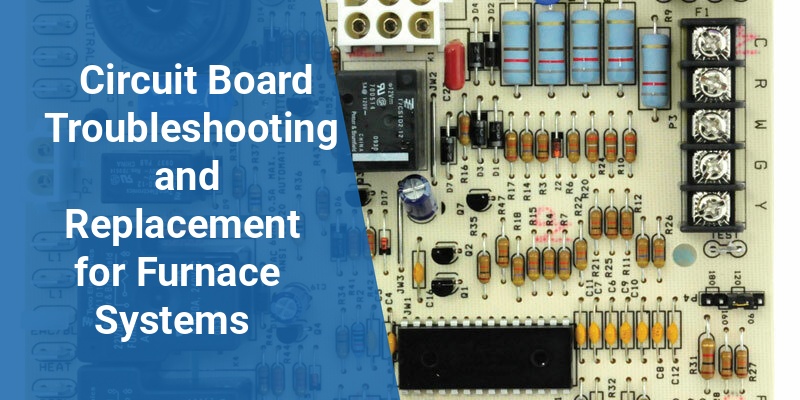A furnace’s circuit board is the central control hub that manages its operation, ensuring proper heating cycles, safety protocols, and communication between components. When the circuit board malfunctions, it can lead to furnace failures, error codes, or inefficient heating. This comprehensive article explores the role of a circuit board in furnaces, common issues, troubleshooting techniques, and guidance on repair or replacement to help homeowners and HVAC professionals maintain optimal furnace performance.
| Aspect | Details |
|---|---|
| Function of Furnace Circuit Board | Controls heating cycles, safety checks, ignitor, blower motor, and sensors |
| Common Symptoms of Board Failure | Furnace not starting, blinking error lights, inconsistent heating, frequent shutoffs |
| Troubleshooting Steps | Visual inspection, error code reading, component testing, professional diagnostics |
| Replacement Tips | Match model numbers, handle with care, consider professional installation |
| Maintenance Advice | Regular inspection, keep area clean, avoid moisture exposure |
Role of the Circuit Board in Furnace Functionality
The furnace circuit board is the electronic control center that orchestrates all furnace operations. It monitors inputs from temperature sensors, flame sensors, and limit switches and sends commands to the ignition system and blower motor. This board ensures the furnace cycles safely, starts and stops at the right time, and maintains desired indoor temperatures efficiently.
Modern furnaces often feature complex circuit boards with microprocessors that manage advanced diagnostics and communicate error codes through LED indicators or digital displays, assisting in identifying issues quickly.
Common Signs of Circuit Board Malfunction in Furnaces
Furnace circuit board problems typically present as operational failures or safety shutdowns. Some common symptoms include:
- Furnace Fails to Ignite: No response when thermostat calls for heat, often due to failed signals from the board.
- Blinking or Steady Error Lights: Most boards have LEDs that flash specific error codes that can be read against the furnace manual.
- Random Furnace Cycles or Shutdowns: Erratic operation or premature shutting off during the heating cycle.
- Blower or Ignitor Not Activating: The blower motor or ignitor may stay off because the board isn’t completing the circuit.
- Overheating or No Heat: Faulty temperature sensor signals processed incorrectly by the board can cause improper heating behavior.
Troubleshooting Furnace Circuit Board Issues
Proper diagnosis is critical before replacing the furnace circuit board as other components can cause similar symptoms. Recommended troubleshooting steps include:
Visual and Physical Inspection
- Check the board for burnt spots, cracked solder joints, or damaged connectors.
- Inspect wiring harnesses for loose or corroded connections.
- Look for signs of moisture or debris that may cause shorts.
Error Code Analysis
Refer to the furnace’s user manual or manufacturer’s website to interpret LED blink codes. These codes pinpoint specific circuit or sensor failures, substantially narrowing down repair focus.
Component Testing
- Use a multimeter to test continuity and voltage across fans, igniters, and sensor inputs to the board.
- Isolate and test individual components to ensure they are functioning properly.
Consult Professional Diagnostics
Due to the complexity of modern furnaces, HVAC technicians use specialized diagnostic tools and software to confirm circuit board faults with precision.
Call 888-906-9139 for Free Local HVAC Quotes – No Obligation, Just Savings!
Guidelines for Furnace Circuit Board Replacement
When troubleshooting suggests a circuit board is defective, proper replacement is key to restoring furnace operation safely and correctly.
Finding the Correct Replacement Board
Ensure the replacement matches the furnace’s make and model number exactly. Circuit boards are typically designed for specific furnace series; an incorrect board may cause compatibility issues.
Handling and Installation Tips
- Turn off power to the furnace at the breaker before starting work to avoid electrical shock.
- Use anti-static precautions when handling the circuit board to avoid damaging sensitive components.
- Follow manufacturer instructions for installation carefully, paying attention to all wiring connections and mounting points.
- Reset the furnace and test operation after installation, monitoring for error codes or abnormal behavior.
When to Hire a Professional
Replacing a furnace circuit board can be complicated. Professional HVAC technicians offer expertise to ensure safe installation, proper programming, and system calibration. This reduces the risk of damage and extends furnace lifespan.
Preventive Maintenance for Furnace Circuit Boards
Regular care can help avoid circuit board failures and costly repairs. Key maintenance tips include:
- Keeping the furnace area clean and free from dust buildup.
- Inspecting the circuit board and connections during annual furnace tune-ups.
- Protecting the furnace from moisture exposure, which can corrode contacts and cause shorts.
- Prompt repair of any detected wiring or component damage.
By incorporating regular maintenance and promptly addressing furnace issues, homeowners can ensure their circuit boards last longer and their heating system operates reliably.
